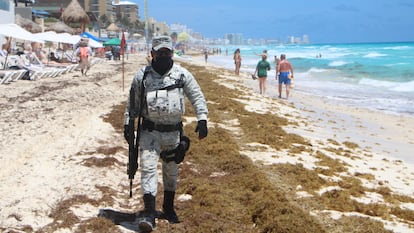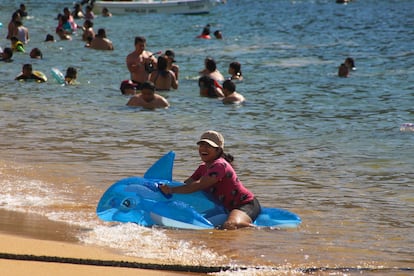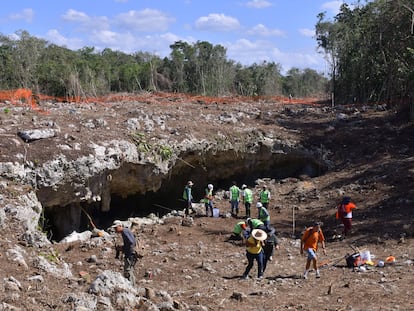Easter in Mexico: How to safely travel in a country riddled by violence
The US State Department has issued advisories classifying different areas according to risk. Only two states are considered safe enough to visit with ‘normal precautions’


Mexican President Andrés Manuel López Obrador recently asserted that “there’s no two places like Mexico,” praising the country’s scenic and cultural riches. He is right. Mexico is unique in more ways than one: it is challenging to find another place in the world that shares the same amount of beauty and violence. This piece of paradise is not always the best place to be, even in the middle of the Easter break.
The US government’s travel advisories for Mexico offer a detailed and helpful map of all the places to avoid. The list includes roads, tourist destinations, pueblos mágicos [an initiative led by Mexico’s Secretariat of Tourism to promote a series of towns offering memorable experiences], and World Heritage Cities. In five states out of 32, the recommendation is “Do Not Travel;” 11 states are on the “Reconsider Travel” list, while 14 more fall under the category “Exercise Increased Caution.” Only two, Campeche and Yucatán, seem to offer peaceful travel, although normal precautions should still be exercised.
Previously golden-era destinations for glamorous Americans such as Acapulco are now off-limits due to safety issues. People from Mexico City still go there on weekends or days off, but they know they cannot take a taxi in the area, especially at night. Violence is now leaving a trail of bodies in a place that used to be an exotic destination. Sites like Zihuatanejo or Ixtapa, two popular destinations among Mexicans and foreign visitors alike, are listed in the US State Department’s Do Not Travel category.
In Guerrero, the town of Taxco is considered an area where limited travel is possible though several restrictions apply, such as using exclusively the Federal Highway 95D that passes through Cuernavaca and Morelos, and staying within downtown tourist areas. The kidnapping of visitors for ransom is common on Mexican roads, so it’s good to check the map beforehand. There are other pueblos mágicos like San Sebastián del Oeste, a rural beauty nestled amongst green mountains and close to Nayarit. It is common to observe off-road vehicles here driven by gang members associated with Mexican cartels, or narcos speeding through the roads in the area. The recommendation of the US authorities is to avoid using the Federal Road 544 between Mascota and San Sebastián.
One of the most interesting states for tourists is Michoacán. The land of the avocados that Americans are so fond of features lakes and beaches, historical sites and monuments. It is also one of the most conflict-ridden places in the country. The most beautiful rural areas are sometimes the most dangerous ones because organized crime uses them as a passage for goods or for deforestation to create more profitable plantations. According to the US Embassy, if anyone must go, travel is limited to areas like the city center and via local Federal Highways (15D, 43, or 48D) or by air only. Even zones like the Monarch Butterfly Reserve are not free of restrictions.

Other idyllic spots remain open despite current violence issues, such as the Caribbean or Baja California, where English and Chinese are heard more often than Spanish. According to the US Travel Advisory, “criminal activity and violence may occur in any location, at any time, including in popular tourist destinations. Travelers should maintain a high level of situational awareness, avoid areas where illicit activities occur, and promptly depart from potentially dangerous situations.”
“While not directed at tourists, shootings between rival gangs have killed or injured innocent bystanders. Additionally, US citizens have been the victims of both non-violent and violent crimes in tourist and non-tourist areas.” Although there are no travel restrictions, “US government employees are advised to exercise increased caution after dark in downtown areas of Cancun, Tulum and Playa del Carmen, and to remain in well-lit pedestrian streets and tourist zones.”
Generally speaking, the most popular tourist destinations are free from the kind of conflict that afflicts the rest of the country, but there are seasons when crime also targets these places. In Quintana Roo, a luxury-hotel destination, the sound of bullets could soon wipe out one of the most appreciated areas for tourism.
Some places free of restrictions for government employees and citizens are Cabo San Lucas, San José del Cabo, and La Paz in Baja California.
Baja California shares the Gulf of California with Sinaloa, a place with beautiful beaches. But it is recommended not to travel to the latter state due to crime and kidnappings. The recommendation for Mazatlan, one of the favorite destinations in the area, is to travel by air or sea only, to stay within the Zona Dorada and historic town center, and to travel via direct routes between these destinations and the airport and sea terminal. The same restrictions apply to Los Mochis and Topolobampo.
Oaxaca is a unique place for travelers thanks to its beautiful diversity: beaches, mountains, traditions, culture, history, monuments and food. A good portion of the territory is safe from gang activity, but travelers must be cautious and avoid the Isthmus region and the border with Chiapas. However, tourist areas and other parts of Oaxaca state like Oaxaca City, Monte Albán, Puerto Escondido and Huatulco are free to visit. With less violence comes more money.
Mexico has places like Zacatecas and Querétaro that are part of the World Heritage Cities. However, tourism in these cities must be undertaken with extreme precautions. Recently, Zacatecas has undergone terrible violence and crime. Many businesses in its beautiful historic city center have closed down, which anyone can see on a walk through the city.
When it comes to tranquility, Guanajuato preserves its colorful capital and the town of San Miguel Allende, one of the most beautiful places in Mexico. Puebla also has no significant problems when it comes to enjoying its immense heritage.
Regarding Mexico City, US authorities note that violent crime does not occur throughout the city, so they recommend avoiding areas less frequented by tourists and exercising increased caution at night. “Petty crime frequently occurs in both tourist and non-tourist areas. US citizens and LPRs [Lawful Permanent Residents] have been victims of kidnapping.”
Recommendations tend to be more restrictive than the actual feeling of safety once travelers they find themselves in a chosen area. Perhaps, Mexico is not the best destination to enjoy at night, but during the day, with proper precautions, there are still thousands of places to go during the Easter break.
Tu suscripción se está usando en otro dispositivo
¿Quieres añadir otro usuario a tu suscripción?
Si continúas leyendo en este dispositivo, no se podrá leer en el otro.
FlechaTu suscripción se está usando en otro dispositivo y solo puedes acceder a EL PAÍS desde un dispositivo a la vez.
Si quieres compartir tu cuenta, cambia tu suscripción a la modalidad Premium, así podrás añadir otro usuario. Cada uno accederá con su propia cuenta de email, lo que os permitirá personalizar vuestra experiencia en EL PAÍS.
¿Tienes una suscripción de empresa? Accede aquí para contratar más cuentas.
En el caso de no saber quién está usando tu cuenta, te recomendamos cambiar tu contraseña aquí.
Si decides continuar compartiendo tu cuenta, este mensaje se mostrará en tu dispositivo y en el de la otra persona que está usando tu cuenta de forma indefinida, afectando a tu experiencia de lectura. Puedes consultar aquí los términos y condiciones de la suscripción digital.
More information
Últimas noticias
Most viewed
- Reinhard Genzel, Nobel laureate in physics: ‘One-minute videos will never give you the truth’
- Oona Chaplin: ‘I told James Cameron that I was living in a treehouse and starting a permaculture project with a friend’
- Pablo Escobar’s hippos: A serious environmental problem, 40 years on
- Chevy Chase, the beloved comedian who was a monster off camera: ‘Not everyone hated him, just the people who’ve worked with him’
- Why we lost the habit of sleeping in two segments and how that changed our sense of time










































